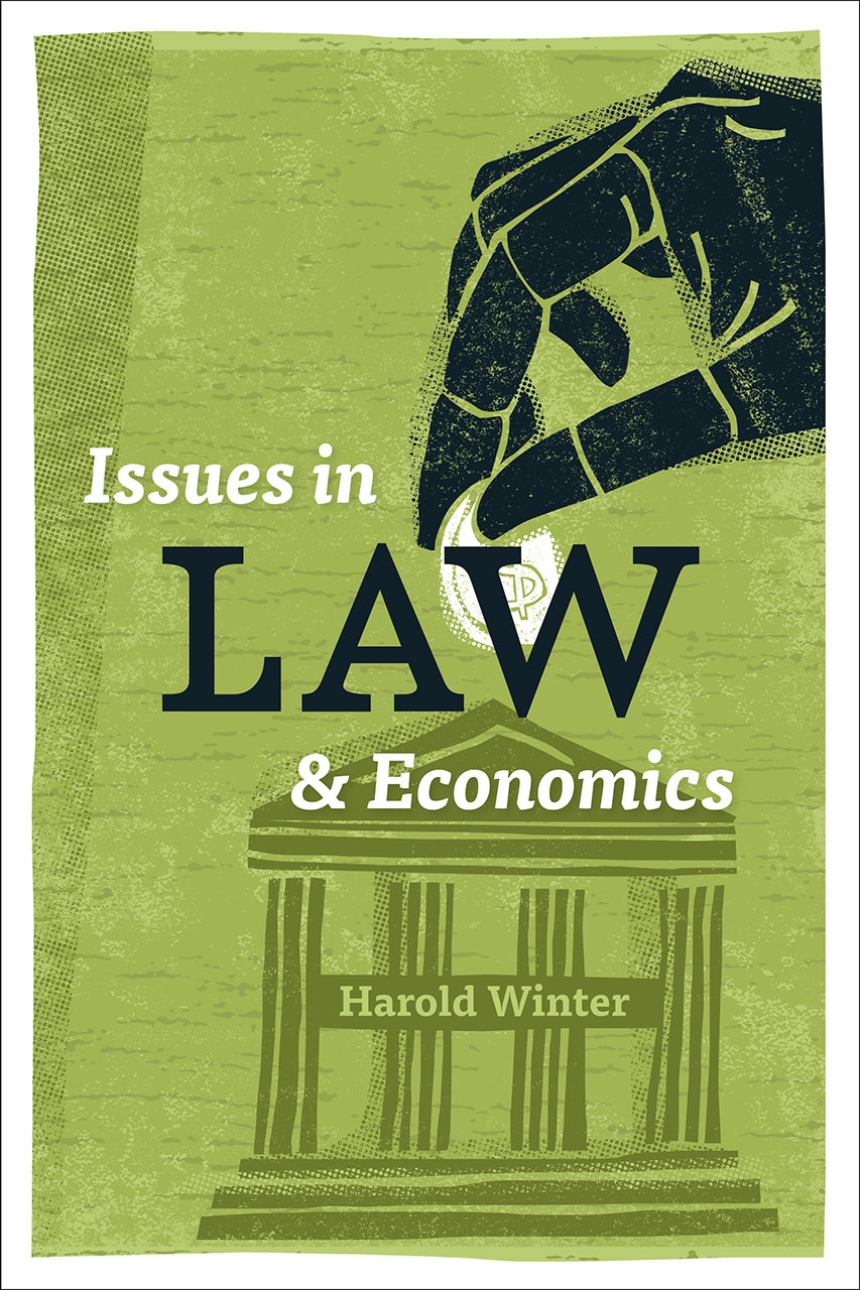Issues in Law and Economics
Is file-sharing destroying the music industry? Should the courts encourage breach of contract? Does the threat of malpractice lawsuits cause doctors to provide too much medical care? Do judges discriminate when sentencing? With Issues in Law and Economics, Harold Winter takes readers through these and other recent and controversial questions. In an accessible and engaging manner, Winter shows these legal issues can be reexamined through the use of economic analysis. Using real-world cases to highlight issues, Winter offers step-by-step analysis, guiding readers through the identification of the trade-offs involved in each issue and assessing the economic evidence from scholarly research before exploring how this research may be used to guide policy recommendations. The book is divided into four sections, covering the basic practice areas of property, contracts, torts, and crime, with a fifth section devoted to a concise introduction to the topic of behavioral law and economics. Each chapter concludes with a series of thought-provoking discussion questions that provide readers the opportunity to further explore important ideas and concepts.
Read the introduction and an excerpt.
240 pages | 6 x 9 | © 2017
Economics and Business: Economics--General Theory and Principles
Law and Legal Studies: Law and Economics
Political Science: Public Policy
Reviews
Table of Contents
Preface
Acknowledgments
Introduction Applying Economic Reasoning to the Law
Part I. Property
Chapter 1. Should Body Parts Be Salable? Moore v. The Regents of the University of California (1990) and the Market for Human Tissue
Chapter 2. Can Anyone Own the Sunlight? Fontainebleau Hotel Corp. v. Forty-Five Twenty-Five, Inc. (1959) and the Assignment and Protection of Property Rights
Chapter 3. Should Eminent Domain Power Be Available to Private Companies? Poletown Neighborhood Council v. City of Detroit (1981) and the Economics of Takings
Chapter 4. Will File Sharing Ruin the Music Industry? A&M Records v. Napster (2001) and the Economics of Copyright Protection
Part II. Contracts
Chapter 5. Should the Courts Encourage Contractual Breach? Acme Mills & Elevator Co. v. J.C. Johnson (1911) and the Economics of Breaking Promises
Chapter 6. Should the Courts Void a Contractual Clause They Deem Unfair? Williams v. Walker Thomas Furniture Co. (1965) and the Paradox of Stipulated Damages
Part III. Torts
Chapter 7. Should Tort Liability Be Governed by Fault or No-Fault Rules? Indiana Harbor Belt Railroad v. American Cyanamid (1990) and the Economics of the Great Debate in Tort Law
Chapter 8. Should Firms Be Held Liable for Product Defects? Voss v. Black and Decker (1983) and the Economics of Product Liability
Chapter 9. Does Malpractice Liability Induce Physicians to Provide Too Much Health Care? Helling v. Carey (1974) and the Economics of Medical Malpractice Law
Part IV. Crime and Punishment
Chapter 10. Are Criminals Rational? Gary Becker and the Dawn of Rational Crime Analysis (1968)
Chapter 11. Does Prison Reduce Crime through Deterrence or Incapacitation? Ewing v. California (2003) and the Economics of the Three-Strikes Law
Chapter 12. Is Racial Profiling a Nondiscriminatory Policing Strategy? Anderson v. Cornejo (2004) and the Economics of Police Search Procedures
Chapter 13. Do Judges Discriminate When Sentencing? The Sentencing Reform Act and Federal Sentencing Guidelines (1984)
Part V. Behavioral Law and Economics
Chapter 14. How Does Behavioral Economics Contribute to the Economic Analysis of Law? A Brief Introduction to the Marriage of Economics and Psychology
Index
Acknowledgments
Introduction Applying Economic Reasoning to the Law
Part I. Property
Chapter 1. Should Body Parts Be Salable? Moore v. The Regents of the University of California (1990) and the Market for Human Tissue
Chapter 2. Can Anyone Own the Sunlight? Fontainebleau Hotel Corp. v. Forty-Five Twenty-Five, Inc. (1959) and the Assignment and Protection of Property Rights
Chapter 3. Should Eminent Domain Power Be Available to Private Companies? Poletown Neighborhood Council v. City of Detroit (1981) and the Economics of Takings
Chapter 4. Will File Sharing Ruin the Music Industry? A&M Records v. Napster (2001) and the Economics of Copyright Protection
Part II. Contracts
Chapter 5. Should the Courts Encourage Contractual Breach? Acme Mills & Elevator Co. v. J.C. Johnson (1911) and the Economics of Breaking Promises
Chapter 6. Should the Courts Void a Contractual Clause They Deem Unfair? Williams v. Walker Thomas Furniture Co. (1965) and the Paradox of Stipulated Damages
Part III. Torts
Chapter 7. Should Tort Liability Be Governed by Fault or No-Fault Rules? Indiana Harbor Belt Railroad v. American Cyanamid (1990) and the Economics of the Great Debate in Tort Law
Chapter 8. Should Firms Be Held Liable for Product Defects? Voss v. Black and Decker (1983) and the Economics of Product Liability
Chapter 9. Does Malpractice Liability Induce Physicians to Provide Too Much Health Care? Helling v. Carey (1974) and the Economics of Medical Malpractice Law
Part IV. Crime and Punishment
Chapter 10. Are Criminals Rational? Gary Becker and the Dawn of Rational Crime Analysis (1968)
Chapter 11. Does Prison Reduce Crime through Deterrence or Incapacitation? Ewing v. California (2003) and the Economics of the Three-Strikes Law
Chapter 12. Is Racial Profiling a Nondiscriminatory Policing Strategy? Anderson v. Cornejo (2004) and the Economics of Police Search Procedures
Chapter 13. Do Judges Discriminate When Sentencing? The Sentencing Reform Act and Federal Sentencing Guidelines (1984)
Part V. Behavioral Law and Economics
Chapter 14. How Does Behavioral Economics Contribute to the Economic Analysis of Law? A Brief Introduction to the Marriage of Economics and Psychology
Index
